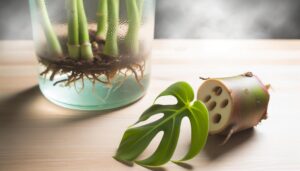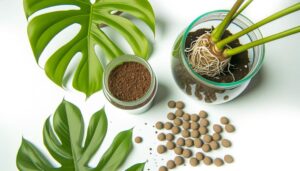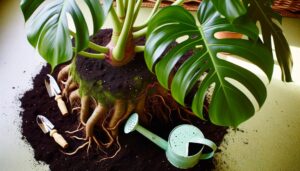Monstera Water Propagation Root Rot: Prevention Tips!
In Monstera water propagation, root rot emerges from stagnant water leading to anaerobic conditions. Pathogens like Pythium and Fusarium thrive without oxygen, causing blackened, mushy roots and declining plant health.
Regularly changing water and promoting oxygenation are essential. Use distilled or filtered water to minimize pathogen exposure, and change it every few days.
Sanitize propagation containers and tools, and place them in indirect light for best photosynthesis. If rot occurs, remove the affected sections with sterilized tools and disinfect healthy roots with diluted hydrogen peroxide.
Learn more for optimal growth of your Monstera in water propagation.
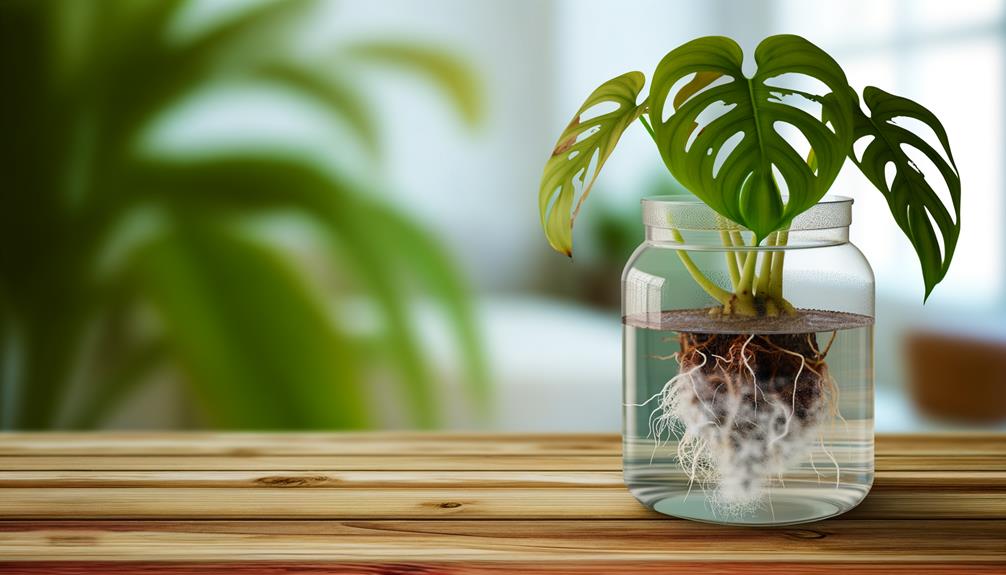
Key Takeaways
- Regularly change water to prevent anaerobic conditions that cause root rot.
- Inspect roots frequently for blackening or mushiness, early signs of root rot.
- Use sterilized tools for taking cuttings and maintain clean propagation containers.
- Disinfect affected roots with diluted hydrogen peroxide to halt the spread of rot.
- Position the container in indirect light and use dechlorinated water to support healthy root growth.
Causes of Root Rot
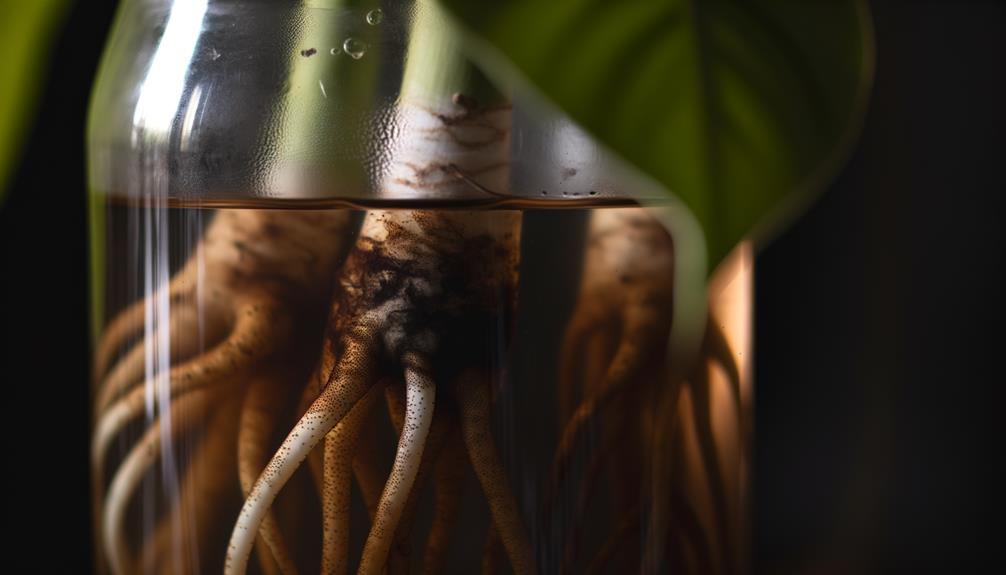
Root rot in Monstera water propagation often occurs due to prolonged exposure to stagnant water, leading to anaerobic conditions that facilitate pathogenic fungal and bacterial growth.
When you propagate Monstera cuttings in water, oxygen diffusion decreases over time, creating an environment where obligate anaerobes thrive. These microorganisms, such as Pythium and Fusarium species, invade the plant’s vascular tissues, impairing nutrient and water uptake.
Additionally, decaying organic matter in the water can release toxins, further stressing the plant. It’s essential to regularly change the water and maintain its oxygenation to mitigate these risks.
Early Signs to Watch For
Early signs of root rot in Monstera water propagation include the appearance of blackened, mushy roots and a noticeable decline in the cutting’s overall health. You’ll observe that affected roots lose their turgidity and turn from white or light tan to a darker hue. These deteriorated roots often emit a foul odor, indicative of bacterial or fungal activity.
Additionally, the cutting may exhibit chlorosis, where the leaves turn yellow due to impaired nutrient uptake. The stem might also show signs of softening and discoloration, suggesting systemic infection. Pay close attention to any reduction in new root growth or leaf development, which signals compromised vascular function.
Detecting these early symptoms allows you to act swiftly to mitigate further damage.
Effective Prevention Tips

Consistently monitor water quality and guarantee that the propagation container is sterilized to prevent the onset of root rot in Monstera cuttings.
Utilize distilled or filtered water to minimize the introduction of pathogens. Change the water every few days to maintain optimal oxygen levels, which inhibit anaerobic bacterial growth.
Ensure cuttings are taken with sanitized tools to prevent contamination. Position the container in indirect light to promote photosynthesis without overheating the water.
Observing the root development daily can help you detect early signs of stress. Using a transparent container aids in visual inspection for any discoloration or slime formation, indicative of bacterial activity.
Implementing these protocols will significantly reduce the risk of root rot, ensuring healthy propagation.
Treatment Methods
To treat root rot in Monstera water propagations, promptly remove the affected cutting from the water, and meticulously examine the roots for signs of decay or discoloration. Utilize sterilized scissors to excise any necrotic or discolored root sections, ensuring you cut back to healthy, white tissue.
Immerse the remaining healthy roots in a diluted hydrogen peroxide solution (1 part hydrogen peroxide to 10 parts water) for 5-10 minutes to disinfect. Replace the propagation water with fresh, dechlorinated water, and add a few drops of liquid rooting hormone to encourage new growth.
Maintain constant observation for further signs of rot, and repeat the hydrogen peroxide treatment if necessary. This protocol maximizes the survival chances of your Monstera cutting.
Maintaining Healthy Roots
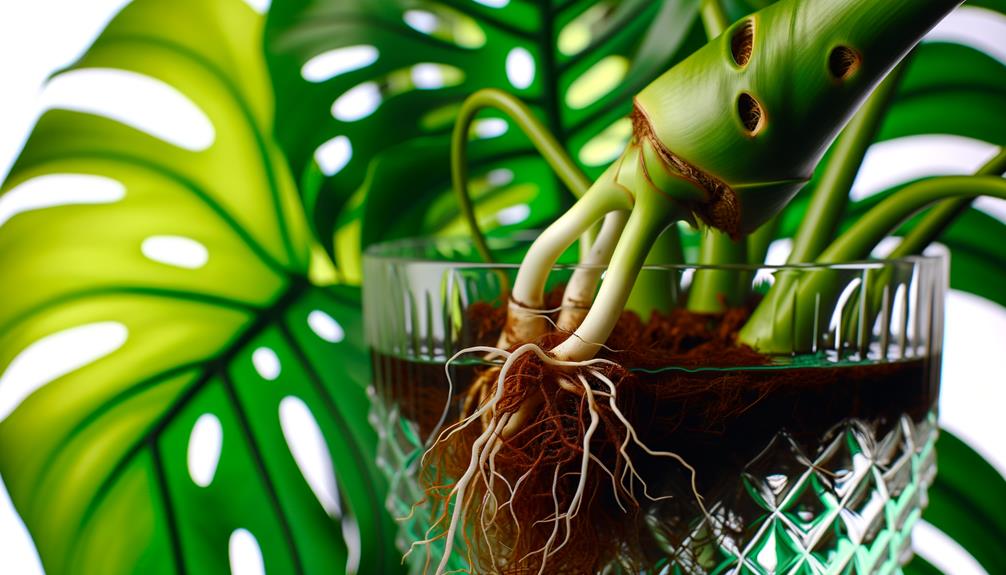
Maintaining healthy roots in Monstera water propagations requires vigilant monitoring of water quality, making sure it remains clear and free of pathogens. You should replace the water every 7-10 days, using dechlorinated water to avoid chemical stress.
Regularly inspect roots for signs of rot, such as browning or mushiness, and remove affected areas with sterilized scissors. Utilize activated charcoal to absorb impurities and prevent bacterial growth. Promote root aeration by using a container that facilitates oxygen exchange.
Conduct periodic pH testing, maintaining levels between 6.0-6.5 to optimize nutrient uptake. Avoid overcrowding cuttings, as limited space can lead to oxygen depletion and increased susceptibility to rot.
Conclusion
To sum up, safeguarding your Monstera from root rot in water propagation is like fortifying a castle against invaders. By carefully monitoring for early signs, implementing preventative measures, and using effective treatments, you can maintain strong and healthy roots.
Remember, consistency is crucial—regular checks and adjustments guarantee your plant thrives. With scientific precision and thorough observation, you’ll master the art of Monstera care, turning possible obstacles into a flourishing success.

